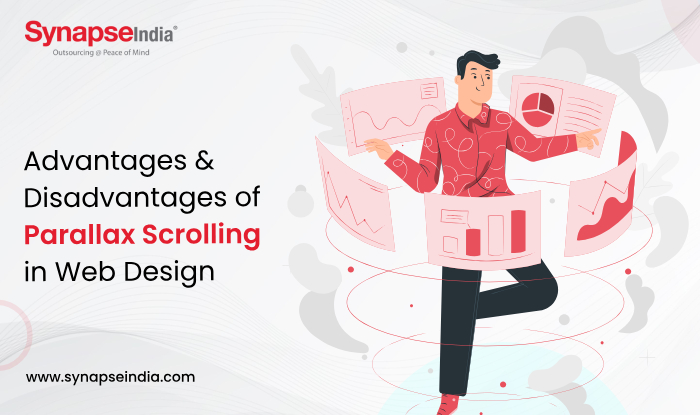 06 May 2024
06 May 2024“Parallax scrolling is a web design technique where background images move at a different speed than foreground images or content as the user scrolls down or up a webpage.”

Parallax scrolling has emerged as a compelling web design trend to provide a dynamic and engaging user experience. Parallax scrolling adds depth and engagement to a webpage by enabling distinct items to move at different speeds, drawing users in and encouraging them to keep scrolling. This method has completely changed the way websites are made, allowing creators to visually arrestingly navigate viewers through content, tell captivating tales, and highlight products. We'll go over the fundamentals of parallax scrolling, its advantages for web design, and how it's changing the online environment in this introduction. Come explore the realm of parallax scrolling with us and learn how it may revolutionize contemporary online experiences.

A common method in web design is using parallax scrolling to give users an immersive and interesting experience. Parallax scrolling gives websites depth and visual intrigue by having distinct content layers move at different speeds as the user scrolls down the page. Because it captures visitors' attention and keeps them interested in the information, this strategy has become more popular in recent years. We'll go over the foundations of parallax scrolling, its history, and its influence on contemporary web design in this introduction. Come along with us as we explore the fascinating realm of parallax scrolling.
Although parallax scrolling can improve a website's aesthetic appeal and user experience, there are certain drawbacks that designers should be aware of:
Complex animations and transitions that are frequently used in parallax scrolling can cause a slowdown in page load times and decreased performance, particularly on older devices or slower internet connections.
Because parallax websites usually consist of a single page, search engine optimization of content might be difficult. There can be restrictions on targeting particular keywords or optimizing meta tags for various sections because all the content is loaded onto one page.
Users with disabilities or those utilizing assistive technologies may have difficulties while utilizing parallax scrolling. Some users may find it challenging to efficiently navigate the website due to complex animations and scrolling effects that conflict with screen readers and other accessibility tools.
When parallax websites don't have clear navigation or easy-to-follow user paths, it can be confusing for users to search for specific content or move between different areas of the website.
Parallax scrolling may not translate well to mobile devices with tiny screens, even if it can work well on desktop computers with huge screens. While interacting with parallax elements, mobile users could run into performance or usability problems.
Overall, designers should carefully evaluate the drawbacks and the unique demands and preferences of their target audience before employing parallax scrolling, even if it can produce visually spectacular and immersive web experiences.

In web design, parallax scrolling provides several benefits, such as:
By enabling various webpage items to move at various speeds as the user scrolls, parallax scrolling gives the viewer a sense of depth and immersion. This enhances the website's visual appeal and has the potential to increase users' engagement and retention.
By showing content in a series of scrolling portions, parallax scrolling may be utilized to lead viewers through a story or narrative. This method is frequently applied to websites to produce engaging, immersive experiences that entice visitors to explore deeper.
Users' attention can be captured and encouraged to participate in the website by the dynamic and interactive nature of parallax scrolling. The use of parallax scrolling in content creation can enhance user engagement and extend visitors' stay on the website.
By providing a distinctive and unforgettable user experience, parallax scrolling may make websites stand out from the crowd. Brands can stand out in a crowded online space by showcasing their creativity and personalities through the use of parallax effects in their designs.
Single-page designs with all content displayed on one continuous page are common on parallax scrolling websites. By doing away with the necessity for visitors to browse through numerous pages in search of information, this can simplify navigation for them. Alternatively, visitors can reach different portions of the page by simply scrolling down.
Designers may communicate information or tell a story more dynamically and captivatingly by utilizing parallax scrolling. Through the use of animation, transitions, and scrolling effects, designers may produce a visually captivating narrative flow that leads viewers through the material.
In general, parallax scrolling is a popular option for designers aiming to build immersive online experiences since it can be a potent tool for improving a website's visual appeal, storytelling potential, and user engagement.
For web designers looking to give users visually appealing and immersive experiences, parallax scrolling has several advantages. All of these benefits—from improved visual appeal and storytelling potential to higher user engagement and easier navigation—combined with parallax scrolling to improve website design and make brands stand out in the crowded online market. When using parallax scrolling, designers should, however, carefully evaluate any potential disadvantages, such as performance problems and accessibility issues, and balance them against the advantages. By utilizing parallax scrolling's benefits and minimizing its drawbacks, web designers may produce captivating websites that enthrall visitors and leave them with unforgettable experiences.


